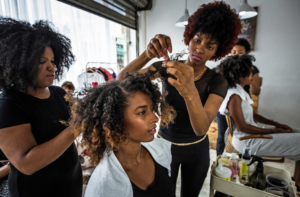Roofers Columbus GA install, repair, and replace the roofs of buildings. They use a variety of materials, including shingles, bitumen, and metal sheets. Some roofers also waterproof and damp-proof walls, swimming pools, and tanks.

Unlike some other construction jobs, roofing work remains stable even during economic downturns. This is due to the consistent need for re-roofing and repairs.
Roofers install, repair, and replace the roofs of buildings to keep interiors dry and safe. They use a variety of roofing materials to achieve this goal. These professionals take detailed measurements before beginning work and lay down layers to create a lasting roof cover. They may start with a vapor barrier or another protective layer, then place shingles or other roofing material over it, making sure that all parts fit tightly and are properly fastened.
When working on new construction, roofers follow architects’ blueprints to determine the amount of roofing materials needed. They also determine the best way to attach the roof to the structural components of the building, such as trusses and beams. Roofers also inspect problem roofs to determine the best repair procedures.
If roofers are re-roofing an existing structure, they begin by clearing the area of any debris. Then, they remove the old shingles and any other outdated roofing materials and dispose of them. They may also install underlayment, which is a sheet of waterproof material that goes over the sheathing before the shingles.
To prevent leaking, roofers nail or cement flashing strips around chimneys, vents, and other rooftop protrusions. They may also install skylights, if the building owner allows it.
During the installation process, roofers follow all applicable safety regulations and practices. They also clean up the work area after each day’s activities. They may also assist other tradesmen on large projects.
Many roofers receive on-the-job training or participate in an apprenticeship program to learn their craft. These programs usually last three years and include a combination of on-the-job experience with classroom instruction. Apprentices earn a wage while learning their trade and often qualify for federal financial aid, including the GI Bill. In addition to these educational programs, roofers can find self-directed learning resources online and at local trade schools. These resources can help them understand the basics of roofing, such as how to use tools and equipment safely. They can also develop essential job skills, such as the ability to interpret and analyze information. They also need good spatial perception to accurately measure and place shingles.
Repair
Roofers must be able to repair leaks and other damage to the roofs of homes and other buildings. This may involve replacing shingles, flashing, or repairing structural damage to the roof. In addition, roofers can also repair siding and gutters. Roofers use a variety of tools to complete these jobs, including power and hand-held tools. They must be able to work in all weather conditions, and they must understand the different types of roofing materials.
When a roofer repairs a leaky roof, they must first locate the source of the leak. This is typically done by checking inside the home for water damage or by examining the area where the leak is occurring. Once they have located the source, they can begin the repair process. This may involve removing shingles or putting in a new layer of tar or rubber sealant. In some cases, roofers must also replace roof vents or work on the underlayment of the roof.
The most common type of roof repair is a simple shingle replacement or patch job. This involves putting down a new layer of shingles on top of the old ones. If there are any holes or cracks in the shingle layer, the roofer can apply some form of waterproof caulk to fix these issues. In some instances, a small hole or crack in the roof can be covered by using colored granules to camouflage the repair.
Other types of roof repair include fixing sagging or warped roof decking, repairing leaky metal valley flashing, and removing and replacing rotten shingle eaves. In some cases, a roofer will need to remove entire sections of the roof to fix severe problems. Roofers also use their skills in other areas of construction, such as working with mortar to patch concrete walls or siding, or using caulk and sealants to waterproof surfaces and structures. They also use critical thinking and coordination to perform their job well. They must be able to adjust their actions in response to the actions of others, and they must be able to communicate effectively with homeowners and coworkers.
Maintenance
Roofers are also responsible for the maintenance of roofs both during and after construction. To keep the roofing system functioning optimally, they monitor weather conditions and inspect the structure for any damage or wear and tear. They repair minor issues and install ventilation ducts to reduce the risk of fire. Depending on the nature of the roofing material, they may also install solar panels.
Most roofers work on both residential and commercial buildings, although some specialize in one or the other. They are trained to use a wide range of roofing materials and can handle flat or low-sloped roofs as well as steep-sloped ones. In some cases, they may be asked to waterproof or damp-proof walls in addition to roofs.
Roofers may also be called upon to install or repair gutter systems, skylights, and chimney stacks. They may use a variety of tools and machinery to complete these tasks, including power saws, drills, and hammers. To protect themselves from heat and other elements while working on a roof, they wear safety glasses and gloves and are required to adhere to all building codes when using ladders.
Because of the many different materials and techniques used in roofing, it is important for roofers to stay updated on new technologies and procedures. Some roofers are also required to take courses in order to maintain their certification. This ensures that they have the necessary skills to tackle any roofing issue that might arise.
Some of the most common duties performed by roofers involve re-shingling and repairing asphalt shingle roofs. They may also be called to install or repair other types of shingles, such as fiberglass or slate shingles. They may also perform roof repairs, such as replacing the flashing or repairing leaks.
Some roofers are also tasked with installing or repairing tar and gravel roofs, which usually have a thicker coating than other roofing materials. These roofs are often found on industrial or commercial structures. To prepare these types of roofs, they might need to sand the existing surface or remove any layers of built-up material. They will then apply a layer of hot bitumen or a single-ply membrane to the structure. To secure these membranes, roofers will use adhesive mechanical fasteners or stone ballast.
